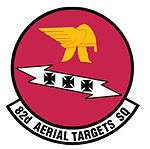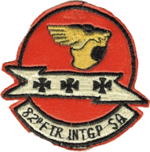82d Aerial Targets Squadron
| 82d Aerial Targets Squadron | |
|---|---|
|
General Ronald E. Keys, commander of Air Combat Command in an 82d ATRS QF-4E Phantom II over the Atlantic Ocean in September 2007, Key's final military flight | |
| Active | 1942-1945; 1946-1971; 1981-present |
| Country |
|
| Branch |
|
| Role | Aerial target operation |
| Garrison/HQ | Tyndall Air Force Base |
| Engagements |
|
| Decorations |
|
| Insignia | |
| 82d Aerial Targets Squadron emblem |
 |
The 82d Aerial Targets Squadron (82 ATRS) is a United States Air Force (USAF) unit. It is assigned to the 53d Weapons Evaluation Group and stationed at Tyndall Air Force Base, Florida.
Overview
The 82d Aerial Targets Squadron (82 ATRS) is the last USAF unit which flies the F-4 Phantom II, flying the QF-4E,-G, and QRF-4C versions in the role of an aerial target. The 82 ATRS also has a Detachment at Holloman AFB to fly QF-4s in support of DoD testing in the White Sands Missile Range (WSMR) Complex.
A secondary mission is the use of man-rated QF-4s in support of the USAF Heritage Flight program at military air shows and other specific commemorative events as authorized by Air Combat Command.[1]
The squadron also maintains three 120-foot drone recovery vessels and two smaller vessels to recover aerial targets and support range safety, patrol, and salvage operations. Squadron members also operate the Air Force’s only two E-9A Widgets, a military version of the de Havilland Canada DHC-8.
In 2013, the squadron commenced acquisition of the first batch of QF-16 aircraft.[2] The QF-16 will eventually replace the QF-4 in the Full Scale Aerial Target (FSAT) role.
History
World War II

The 82d Fighter Squadron saw combat in the ETO from 13 April 1943 to 25 April 1945, and training, maneuvers, and air defense, from April to September 1945. It was part of the occupation forces in Germany from August 1946 to June 1947. It served in air defense in United States from January 1949 to March 1953 and from October 1954 to February 1966.
Air Defense Command/Aerospace Defense Command Fighter-Interceptor Unit

During the Cold War, the then-82d Fighter-Interceptor Squadron (82 FIS) was an Air Defense Command (ADC) tenant unit based at Travis Air Force Base, California.
On 22 October 1962, before President John F. Kennedy told Americans that Soviet ballistic missiles were in place in Cuba, the squadron dispersed one third of its force, equipped with nuclear tipped missiles to Siskiyou County Airport at the start of the Cuban Missile Crisis.[3][4] However, before the crisis was over, on 26 October, the planes returned to Travis AFB because of overcrowding at Siskiyou.[5]
In 1966, the 82 FIS was deployed to Naha Air Base, Okinawa.
The prime aircraft of the squadron was the F-102 Delta Dagger, or "Deuce", which was the more common nickname. In order to deploy to Naha, each plane was configured with refueling probes and required extensive pilot training. This was one of the few times such a modification was done to a relatively short-ranged jet fighter-interceptor. In January 1968, the 82d was scrambled to South Korea in response to the Pueblo Incident, where North Korea had seized the intelligence ship USS Pueblo. The 82d Fighter Interceptor Squadron maintained a presence in South Korea with a detachment of temporarily assigned aircraft (12) and personnel (TDY) to Suwon Air Base, ROK. The squadron continued this service until 31 May 1971 when the 51st Fighter Inteceptor Wing (51 FIW), along with all the other operational and support squadrons (including the 82d Fighter Interceptor Squadron) were inactivated.
Air Training Command
From 1972 to 1976, the 82d was redesignated as the 82d Flying Training Squadron (82 FTS), part of the 78th Flying Training Wing (78 FTW) of the Air Training Command (ATC), conducting Undergraduate Pilot Training for USAF and NATO/Allied students at Webb AFB, Texas in the T-41, T-37 and T-38. With the end of the Vietnam War and a reduced need for USAF pilots, the 82 FTS was inactivated in 1976 and the 78 FTW inactivated and Webb AFB closed in 1977 as part of post-Vietnam defense spending reductions.
Aerial Target Unit
On 1 July 1981 the 82d Tactical Aerial Targets Squadron was assigned to the 325th Fighter Weapons Wing at Tyndall AFB, Florida. On 15 October 1983, the 82d Tactical Aerial Targets Squadron was transferred to the 475th Weapons Evaluation Group. It is now part of the 53d Weapons Evaluation Group.
.jpg)
The 82d Aerial Targets Squadron is very unusual by the type of aircraft it operates. This squadron is the only unit left in the USAF to fly the venerable F-4 Phantom II reduced to the role of aerial targets. Located at Tyndall AFB, Florida, the 82 ATRS is a subordinate of the 53d Weapons Evaluation Group (53 WEG) assigned to Air Combat Command's 53d Wing (53 WG) at Eglin AFB, Florida. The 53 WEG is responsible for conducting the USAF Air-to-Air Weapons System Evaluation Program known as Combat Archer from Tyndall AFB and the Air-to-Ground version known as Combat Hammer from Eglin AFB. Both bases are located at short distances from each other in the Florida panhandle. During these exercises, the 82 ATRS provides drone targets such as the QF-4 in the Full Scale Aerial Target (FSAT) role next to the MQM-107 Streaker and BQM-34 Firebee as Sub-Scale Aerial Targets (SSAT). To perform surveillance and gather telemetry data during shooting over the Gulf of Mexico, the units uses the only two E-9A in the USAF inventory. The E-9A is a special version of the civilian DHC-8 ("DASH-8") specially equipped with a large phased-array antenna on the right side of the fuselage. The E-9A can record all data onboard and can retransmit it in real time to the ground control station. Also called "Tyndall Navy" is the Watercraft Branch of the 82 ATRS. It comprises three 120 ft drone recovery vessels designated MR-120 and two smaller vessels. These vessels are used for providing direct sea support to recover aerial targets like the MQM-107 and BQM-34, range safety patrols and salvage operations.[6] The 82 ATRS also has a Detachment at Holloman AFB which is responsible for FSAT operations at the White Sands Missile Range near Holloman AFB, New Mexico.
Modifications to the airframe and installation of major systems to transform the F-4 takes about four months. This includes installation of the primary and back-up Automatic Flight Control System, Command/Telemetry System, VDOPS Scoring System, Flight Termination System, Visual Enhancement System and Ancillary Subsystems.
There are two kinds of QF-4s. The first is NULLO Full-Scale Aerial Target which keep the above basic drone conversions. For the 82d, NULLO means Not Under Live Local Operation. A NULLO flight always requires at least three drones, the one to be shot down, a spare and a manned QF-4 flying as chase plane. The second one is the manned full-scale drones fitted with advanced countermeasure systems installed by the USAF. While some of the twin-stick QF-4s retain their dual control system as trainers and both ejection seats in working order, the other manned QF-4s have the rear cockpit ejection seat removed. All NULLO aircraft have both ejection seats removed. Noticeable differences between the two are the six antennas from the VDOPS scoring system, the hump on top of the fuselage, a crude box on the left intake and a fairing in the left forward Sparrow III missile well.
Lineage

- Constituted 82d Pursuit Squadron (Interceptor) on 13 January 1942
- Activated on 9 February 1942
- Re-designated: 82d Pursuit Squadron (Interceptor) (Twin Engine) on 22 April 1942
- Re-designated: 82d Fighter Squadron (Twin Engine) on 15 May 1942
- Re-designated: 82d Fighter Squadron on 1 March 1943
- Inactivated on 18 October 1945
- Re-designated 82d Fighter Squadron, Single Engine c. July 1946
- Activated on 20 August 1946
- Re-designated: 82d Fighter Squadron, Jet c. November 1948
- Re-designated: 82d Fighter-Interceptor Squadron on 20 January 1950
- Inactivated on 31 May 1971
- Re-designated 82d Flying Training Squadron on 14 April 1972
- Activated on 1 December 1972
- Inactivated on 15 June 1976
- Re-designated 82d Tactical Aerial Target Squadron on 17 June 1981
- Activated on 1 July 1981
- Re-designated: 82d Tactical Aerial Targets Squadron on 30 September 1982
- Re-designated: 82d Aerial Targets Squadron on 1 November 1991[7]
Assignments
|
|
Stations
|
|
Aircraft
|
|
References
Notes
- ↑ http://www.airforceheritageflight.org/
- ↑ http://www.boeing.com/boeing/Features/2013/09/bds_qf16_09_23_13.page
- ↑ McMullen, Richard F. (1964) “The Fighter Interceptor Force 1962-1964” ADC Historical Study No. 27, Air Defense Command, Ent Air Force Base, CO (Confidential, declassified 22 Mar 2000), pp. 10-12
- ↑ NORAD/CONAD Participation in the Cuban Missile Crisis, Historical Reference Paper No. 8, Directorate of Command History Continental Air Defense Command, Ent AFB, CO , 1 Feb 63 (Top Secret NOFORN declassified 9 March 1996). P. 16
- ↑ NORAD/CONAD Participation in the Cuban Missile Crisis, p. 18
- ↑ EIA - FY2003
- 1 2 3 4 AFHRA 82d Aerial Targets Squadron Lineage and history
Bibliography
![]() This article incorporates public domain material from websites or documents of the Air Force Historical Research Agency.
This article incorporates public domain material from websites or documents of the Air Force Historical Research Agency.
- Cornett, Lloyd H.; Johnson, Mildred W. (1980). A Handbook of Aerospace Defense Organization, 1946–1980 (PDF). Peterson AFB, CO: Office of History, Aerospace Defense Center.
- Maurer, Maurer, ed. (1982) [1969]. Combat Squadrons of the Air Force, World War II (PDF) (reprint ed.). Washington, DC: Office of Air Force History. ISBN 0-405-12194-6. LCCN 70605402. OCLC 72556.
- McMullen, Richard F. (1964) “The Fighter Interceptor Force 1962-1964” ADC Historical Study No. 27, Air Defense Command, Ent Air Force Base, CO (Confidential, declassified 22 Mar 2000), pp. 10–12
- "ADCOM's Fighter Interceptor Squadrons". The Interceptor (January 1979) Aerospace Defense Command, (Volume 21, Number 1)
- NORAD/CONAD Participation in the Cuban Missile Crisis, Historical Reference Paper No. 8, Directorate of Command History Continental Air Defense Command, Ent AFB, CO, 1 Feb 63 (Top Secret NOFORN declassified 9 March 1996)
External links
- USAFHRA information sheet, 82d Aerial Targets Squadron
- www.tyndall.af.mil — U.S. Air Force Fact sheet which covers the 82d Aerial Targets Squadron
| |||||||||||||||||||||||||||||||||||||||||||||||


